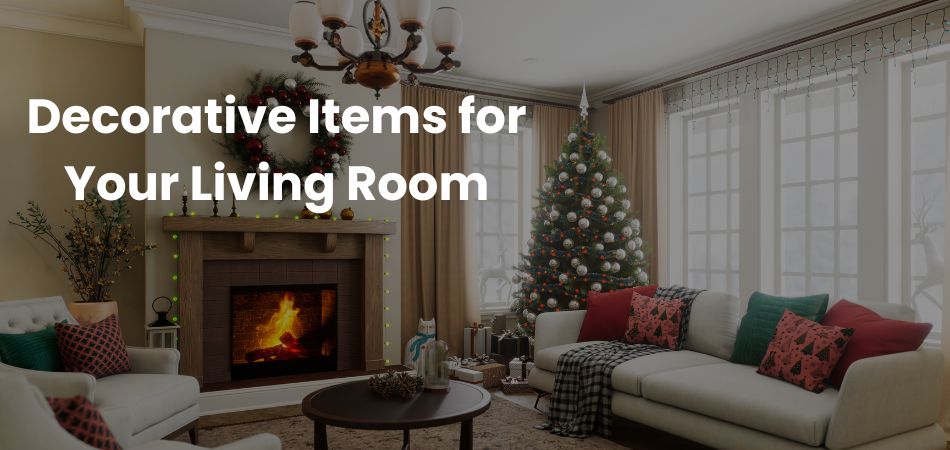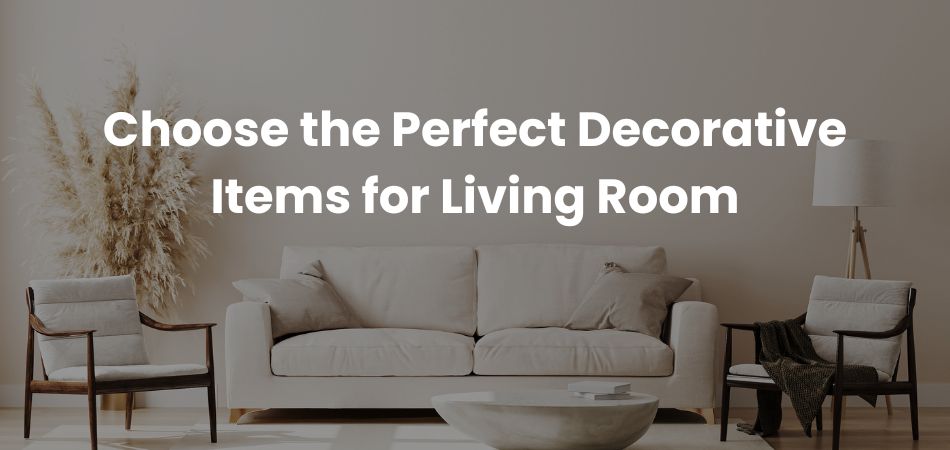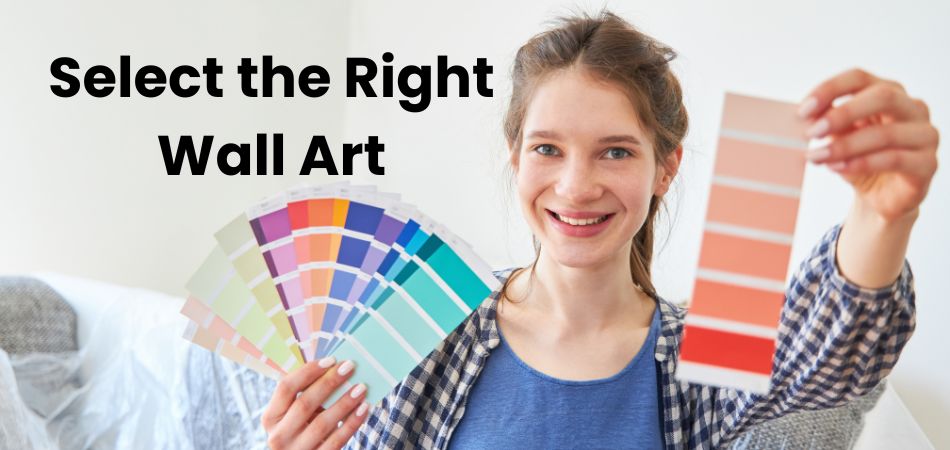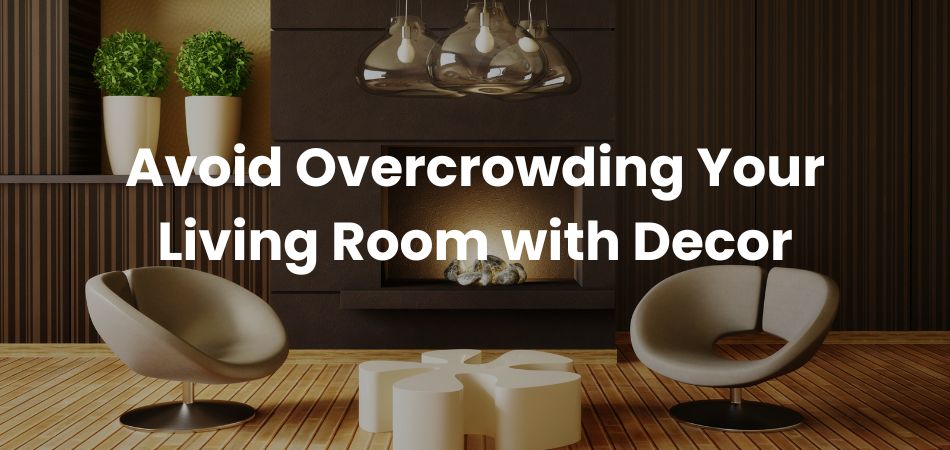Decorating your living room is more than just an aesthetic pursuit—it’s about creating a space that feels inviting, reflects your personality, and serves as the heart of your home.
With so many options available, finding the right pieces to complement your style can feel overwhelming. So, how do you choose the perfect decorative items for living room?
To choose the perfect decorative items for your living room, consider your room’s style, color palette, and functionality. Focus on creating harmony, incorporating textures, and adding personal touches. Don’t forget to consider scale and use statement pieces for impact.
This guide will help you get the most out of interior decor, offering tips and ideas to curate a living room that’s both functional and aesthetically pleasing.
Why Should You Decorate Your Living Room Elegantly?
Decorating home elegantly not only increases the room’s functionality but also sets the tone for your entire home. Here are some reasons why an elegant living room is worth the effort.
Creates a Welcoming Atmosphere
An elegantly decorated living room instantly creates a warm and inviting atmosphere. It offers a space where guests feel comfortable and appreciated from the moment they walk in. The right blend of design, color, and furniture makes the room feel like a place where people can relax and unwind.
Reflects Your Personal Style
Your living room is a direct reflection of your personality and taste. Elegant decor allows you to showcase your personal sense of style through furniture, accessories, and art. Whether you prefer modern, traditional, or eclectic designs, your choices tell a story and create a lasting impression.
Increases the Perceived Value of Your Home
A well-decorated living room enhances the overall appeal and value of your home. Potential buyers or guests will notice the attention to detail and thoughtful design. Elegant decor can make your home feel more luxurious, helping you stand out whether you’re hosting or considering selling in the future.
Promotes Comfort and Relaxation
Elegance isn’t just about aesthetics—it’s about comfort too. A thoughtfully decorated living room combines beauty with functionality, ensuring that the space is both visually appealing and comfortable. The right furniture and accessories can encourage relaxation, making your living room the perfect place to de-stress.
Improves the Flow and Function of the Room
An elegant living room is often designed with careful attention to space and layout. Proper arrangement of furniture and decor items ensures that the room is both functional and visually balanced. With an organized, stylish environment, you can enjoy a more harmonious and efficient living space.
Must-have Decorative Items for Your Living Room
A well-decorated living room combines both functionality and style, creating a space that feels cozy yet sophisticated. To achieve this balance, certain decorative items are essential for adding personality, warmth, and elegance to the room. Here are some must-have decorative items for your living room:

- Mirrors: Mirrors reflect light, making your living room feel more spacious and brighter. They also add a touch of sophistication and can serve as a striking focal point on a wall.
- Photo Frames: Personalize your space with photo frames showcasing cherished memories. These frames can range from classic to modern designs, complementing your room’s overall decor style.
- Clocks: A stylish wall clock adds both functionality and a statement piece to your living room. Opt for a design that matches the theme of the space, whether vintage or contemporary.
- Planters: Indoor plants are essential for bringing life and color into the living room. Choose planters that match your decor, whether sleek modern pots or rustic, woven baskets.
- Vases: Vases are perfect for showcasing fresh flowers or as standalone decorative pieces. They can range from minimalist glass designs to ornate ceramic or metallic finishes.
- Baskets: Functional yet decorative, baskets help keep your living room tidy. Use them for storage or as decorative pieces to hold throws, magazines, or other items.
- Candle Holder: A candle holder adds a touch of elegance and warmth to the room. Whether it’s a single piece or a grouping of candles, they help create a cozy, ambient atmosphere.
- Home Fragrance: Scented candles, diffusers, or essential oils contribute to the sensory appeal of your living room. A pleasant fragrance can make the space feel more inviting and relaxing.
- Plants and Flowers: Fresh flowers and greenery bring a natural element to your decor. Whether you opt for a vase of fresh blooms or low-maintenance indoor plants, they add vibrancy and life to any room.
- Decorative Bowls and Plates: Decorative bowls and plates serve both functional and ornamental purposes. Use them to display fruit, decorative stones, or as simple accent pieces on tables or shelves.
- Wall Art: Art prints or paintings create an instant focal point and inject personality into your living room. Choose artwork that resonates with your style, from modern abstracts to vintage posters.
- Carpets: A beautiful carpet or rug adds warmth, texture, and color to your living room. It anchors the space, defines areas, and adds comfort to hardwood or tile floors.
- Figurines: Decorative figurines or sculptures add artistic flair to shelves, tables, or mantels. Choose pieces that reflect your interests or travel memories for a personal touch.
- Wall Decor: Wall decor such as shelves, mirrors, or tapestries can complement the design of any living room. These items provide texture, dimension, and serve as great conversation starters.
- Artificial Flowers: If you lack a green thumb, artificial flowers can provide the same beauty as fresh blooms. They require no maintenance and last much longer, while still adding color and charm.
- Candles: Candles are perfect for creating mood lighting in the living room. Whether in holders or simply placed on trays, they offer both style and a soothing atmosphere.
- Lamps: A stylish lamp can brighten up a room while enhancing its aesthetic. Choose from table lamps, floor lamps, or pendant lights to suit the space and provide functional illumination.
- Table Accents: Small decorative items such as trays, sculptures, or books on coffee tables or side tables add personality to your living room. These accents allow you to showcase your style in a subtle way.
How Do You Choose the Perfect Decorative Items for Living Room?
Choosing the right decorative items for your living room can be a challenge, but with thoughtful planning, you can create a space that feels both stylish and comfortable. The key is to select pieces that reflect your personality while maintaining a cohesive design. Here’s a guide to help you make the best choices for your living room decor.

1. Consider Your Living Room’s Overall Style
Before selecting decorative items, establish a clear style for your living room, whether it’s modern, traditional, or eclectic. Items should complement this style, creating a cohesive look that flows throughout the space. Don’t mix too many contrasting styles—keep the focus on harmony to maintain a balanced environment.
2. Choose a Color Palette
Your color palette sets the tone for the room, so select decorative items that complement or accentuate your chosen hues. Stick to a few main colors and use them in your pillows, rugs, vases, and artwork to create a cohesive look. Accents of metallic or neutrals can add contrast and visual interest without overwhelming the space.
3. Focus on Functionality and Aesthetics
Decorative items should not only look good but also serve a functional purpose in your living room. For example, choose stylish baskets or trays that can help with storage, or select elegant lamps that provide both light and ambiance. By balancing beauty with utility, you’ll create a space that is both practical and visually appealing.
4. Incorporate Texture and Layers
Adding different textures can improve the look and feel of your living room. Use throw blankets, cushions, and rugs to introduce warmth and tactile interest. Layering textures with decorative pillows, textiles, or even wood and metal elements helps to create depth in your design.
5. Add Personal Touches
Incorporate personal items such as family photos, souvenirs, or meaningful artwork to make the space feel uniquely yours. These personal touches will infuse your living room with character and create a welcoming atmosphere for guests. Just make sure to balance these personal items with your overall decor to avoid overcrowding.
6. Think About Scale and Proportion
When selecting decorative items, consider the size and scale of both the room and the items themselves. Oversized furniture might require larger decorative pieces, while smaller spaces benefit from more delicate accessories. Maintain proportion to ensure the room doesn’t feel cluttered or under-decorated.
7. Create Focal Points with Statement Pieces
Every living room needs a focal point, and decorative items like a large piece of art, original sculpture, or a bold lamp can help achieve this. Choose one or two statement pieces that draw attention and set the tone for the room’s overall design. This creates visual interest and anchors the rest of your decor choices.
Small Living Room Decorating: How to Choose Items?
It can be challenging to decorate a small living room, but it can also be a wonderful opportunity to create a cozy and stylish retreat. The key is to select items that maximize space, add personality, and make the room feel open and inviting. Here are some tips for choosing the right items for a small living room.
- Opt for Multi-Functional Furniture: In a small space, every piece of furniture should serve more than one purpose. You can consider a sofa with storage underneath or a coffee table that doubles as a desk to save space without compromising style.
- Use Light and Neutral Colors: Light colors on walls, furniture, and decor can make a small room feel larger and airier. Neutral tones like whites, beiges, and soft grays reflect light and create a sense of openness in confined spaces.
- Go for Sleek, Compact Designs: Choose furniture and decor with a minimalist, streamlined design to avoid overcrowding the room. Opt for a slim-profile sofa or wall-mounted shelves that free up floor space while maintaining style.
- Add Vertical Storage: To avoid clutter, utilize vertical space with tall shelves, hanging plants, or wall-mounted storage. Vertical storage keeps the floor area open while still offering plenty of room for your decorative items.
- Incorporate Reflective Surfaces: Mirrors, glass furniture, or metallic finishes can create the illusion of space by reflecting light and visually expanding the room. A strategically placed mirror can make the living room feel more spacious and airy.
Role of Colors and Textures in Living Room Decor
Colors and textures play a fundamental role in setting the tone and atmosphere of your living room. The right color palette can evoke specific emotions—warm tones like red and orange create a cozy, inviting feel, while cool shades like blue and green offer a sense of calm and relaxation. A balanced mix of complementary and accent colors ensures a cohesive look, while pops of bold hues can add personality and vibrancy.
Textures, on the other hand, bring depth and dimension to your living room. Soft fabrics like velvet or cotton on cushions and throws can make the space feel warm and comforting, while harder materials like wood or metal add structure and sophistication. Layering textures, such as pairing a plush rug with a sleek leather sofa, enhances the visual appeal and tactile experience of the room.
Combining colors and textures thoughtfully can transform your living room into a harmonious, stylish space. By mixing and matching these elements, you can create an environment that reflects your personality and suits your functional needs. Together, they turn an ordinary living room into an extraordinary living space.
How to Select the Right Wall Art for Your Space?
Choosing the right wall art is a key part of your living room’s decor. It not only reflects your personality but also helps define the mood of the space. Here are some tips for selecting the perfect wall art for your living room.

- Consider the Size of the Wall: Large walls benefit from oversized art pieces or a gallery wall to fill the space without looking too sparse. On smaller walls, a single statement piece or a pair of complementary artworks works best to avoid overcrowding.
- Match the Art to Your Color Scheme: Wall art should harmonize with your existing color palette to create visual balance. Choose pieces that either complement the dominant tones in the room or add a bold contrast to make a statement.
- Choose Art That Reflects Your Personality: Your wall art should be a reflection of your tastes and interests. Whether you prefer abstract, nature-inspired, or vintage art, make sure it resonates with you and adds to the overall vibe of the room.
- Frame Selection is Key: The frame can significantly impact the overall look of the art. Opt for frames that suit your style—sleek metal frames for modern looks or ornate wooden ones for a more traditional or rustic feel.
Impact of Good Rugs and Cushions on Your Living Room Design
Rugs and cushions are essential elements that can instantly upgrade the style and comfort of your living room. A well-chosen rug not only anchors the space but also defines different areas within the room, particularly in open-plan designs. It adds warmth to hardwood or tile floors, creating a cozy and inviting atmosphere.
Cushions, on the other hand, bring a personal touch and a burst of color or texture to your sofa or chairs. They can help soften the overall look of a room and provide an opportunity to experiment with patterns, materials, and accents. Whether in rich velvet, playful prints, or neutral tones, cushions add visual interest and comfort to your seating area.
Together, rugs and cushions play a significant role in making a living room feel complete. They offer functional benefits, such as warmth and comfort, while also enhancing the room’s aesthetic appeal and contributing to the overall design cohesion.
How to Avoid Overcrowding Your Living Room with Decor?
Decorating your living room can be exciting, but it’s easy to go overboard with too many items. Choose decor that enhances the room without overwhelming it in order to maintain a balanced, harmonious atmosphere. Here are some tips to avoid overcrowding your living room with decor.

- Stick to a Few Key Pieces: Focus on a few statement pieces that will stand out rather than filling the space with numerous smaller items. Quality over quantity ensures your living room feels curated and not cluttered.
- Make Use of Vacant Space: Don’t feel the need to fill every inch of the room. Leaving areas of negative space around furniture and decor can make the room feel more open and airy.
- Limit the Number of Accessories: Keep accessories like vases, sculptures, and decorative objects to a minimum. Too many accessories can compete for attention and make the room feel chaotic.
- Opt for Functional Decor: Choose items that serve both a decorative and functional purpose, such as stylish baskets or storage ottomans. This helps reduce clutter while still adding beauty to the room.
- Regularly Edit Your Decor: Periodically reassess your decor to ensure it still serves the space. Removing or rotating pieces can keep the room fresh without overcrowding it with unnecessary items.
Frequently Asked Questions (FAQs)
Decorating your living room can be a daunting task, especially when trying to balance style and functionality. Here are some frequently asked questions to help guide your design choices.
1. What Are the Best Colors for a Small Living Room?
Light and neutral colors, like whites, beiges, and soft grays, are ideal for small living rooms as they make the space feel larger and more open. You can add depth by incorporating accent colors through accessories such as cushions, rugs, or wall art. Avoid dark, heavy colors that can make the room feel cramped and closed off.
2. How Do I Make My Living Room Look Bigger?
To make a small living room appear bigger, opt for furniture with a light color or sleek, minimalistic design. Keep the space neat and use mirrors to reflect light and create openness. Additionally, vertical storage can free up floor space while still keeping the room functional.
3. Should I Choose Matching Furniture for My Living Room?
Matching furniture creates a cohesive, uniform look, but it can sometimes feel too rigid or lack personality. Mixing different furniture pieces in complementary colors or styles adds character and allows for more creative expression. As long as there’s a unifying element, like color or material, mixing pieces can work beautifully.
4. How Can I Add Personality to My Living Room Without Overcrowding?
To add personality without overcrowding, focus on a few key statement pieces, like unique artwork or a vintage piece of furniture. Incorporate personal touches through smaller accessories, such as throw pillows, books, or plants. Keep the overall layout open and uncluttered, using accessories to infuse charm without overwhelming the space.
5. What’s the Best Lighting for a Living Room?
A layered approach to lighting is best for a living room, combining ambient, task, and accent lighting. Start with overhead lighting for general illumination, then add floor lamps or table lamps for reading or focused tasks. Consider accent lighting, like wall sconces or dimmable lights, to create a cozy, inviting atmosphere.
Final Thoughts
Decorating your living room is all about creating a space that feels both functional and reflective of your personal style. By carefully selecting items that balance aesthetics with practicality, you can turn your living room into a welcoming and stylish retreat.
Whether you focus on colors, textures, or specific decor pieces, each element plays a role in enhancing the overall ambiance. When considering “How do you choose the perfect decorative items for living room,” remember to select items that not only look beautiful but also contribute to the room’s comfort and flow.
